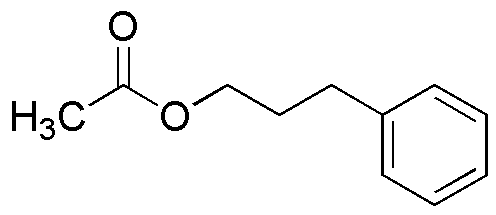3-Phenylpropyl acetate is widely utilized in research focused on:
- Flavor and Fragrance Industry: This compound is commonly used as a flavoring agent in food products and as a fragrance component in perfumes, providing a sweet, fruity aroma that enhances sensory experiences.
- Pharmaceuticals: It serves as an intermediate in the synthesis of various pharmaceutical compounds, aiding in the development of medications with improved efficacy and stability.
- Cosmetics: The chemical is incorporated into cosmetic formulations, contributing to the scent and enhancing the overall appeal of products like lotions and creams.
- Research Applications: In academic and industrial research, it is utilized in studies related to organic synthesis and reaction mechanisms, helping scientists explore new chemical pathways.
- Solvent Properties: Its properties make it an effective solvent for various organic reactions, providing a medium that can enhance reaction rates and yields compared to other solvents.
Informations générales
Propriétés
Sécurité et réglementation
Applications
3-Phenylpropyl acetate is widely utilized in research focused on:
- Flavor and Fragrance Industry: This compound is commonly used as a flavoring agent in food products and as a fragrance component in perfumes, providing a sweet, fruity aroma that enhances sensory experiences.
- Pharmaceuticals: It serves as an intermediate in the synthesis of various pharmaceutical compounds, aiding in the development of medications with improved efficacy and stability.
- Cosmetics: The chemical is incorporated into cosmetic formulations, contributing to the scent and enhancing the overall appeal of products like lotions and creams.
- Research Applications: In academic and industrial research, it is utilized in studies related to organic synthesis and reaction mechanisms, helping scientists explore new chemical pathways.
- Solvent Properties: Its properties make it an effective solvent for various organic reactions, providing a medium that can enhance reaction rates and yields compared to other solvents.
Documents
Fiches de données de sécurité (FDS)
La FDS fournit des informations de sécurité complètes sur la manipulation, le stockage et l’élimination du produit.
Spécifications du produit (PS)
Le PS fournit une description complète des propriétés du produit, notamment sa composition chimique, son état physique, sa pureté et les exigences de stockage. Il détaille également les plages de qualité acceptables et les applications prévues du produit.
Certificats d'analyse (COA)
Recherchez des certificats d'analyse (COA) en saisissant le numéro de lot du produit. Les numéros de lot et de lot se trouvent sur l'étiquette d'un produit, après les mots « Lot » ou « Lot de fabrication ».
Numéro de catalogue
Numéro de lot/série
Certificats d'origine (COO)
Ce certificat d'exploitation confirme le pays dans lequel le produit a été fabriqué, et détaille également les matériaux et composants utilisés et s'il est issu de sources naturelles, synthétiques ou autres sources spécifiques. Ce certificat peut être requis pour les douanes, le commerce et la conformité réglementaire.
Numéro de catalogue
Numéro de lot/série
Fiches de données de sécurité (FDS)
La FDS fournit des informations de sécurité complètes sur la manipulation, le stockage et l’élimination du produit.
DownloadSpécifications du produit (PS)
Le PS fournit une description complète des propriétés du produit, notamment sa composition chimique, son état physique, sa pureté et les exigences de stockage. Il détaille également les plages de qualité acceptables et les applications prévues du produit.
DownloadCertificats d'analyse (COA)
Recherchez des certificats d'analyse (COA) en saisissant le numéro de lot du produit. Les numéros de lot et de lot se trouvent sur l'étiquette d'un produit, après les mots « Lot » ou « Lot de fabrication ».
Numéro de catalogue
Numéro de lot/série
Certificats d'origine (COO)
Ce certificat d'exploitation confirme le pays dans lequel le produit a été fabriqué, et détaille également les matériaux et composants utilisés et s'il est issu de sources naturelles, synthétiques ou autres sources spécifiques. Ce certificat peut être requis pour les douanes, le commerce et la conformité réglementaire.

